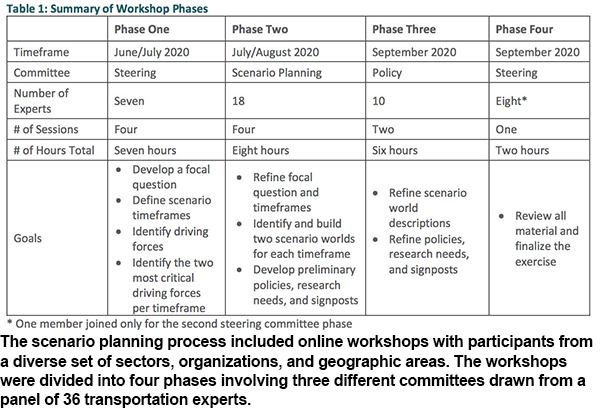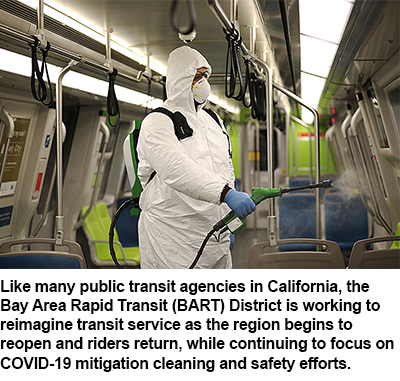A UC ITS Report Offers Several Key Takeaways and a Model for Scenario Analysis That Could Make Future Transit Planning More Agile
By Stephanie Jordan
Managing Editor
Transit California

What are sustainable and equitable, short- and longer-term public transit and shared mobility policies for all communities under different scenarios in the context of the global pandemic and recovery? This is the focal question that researchers Susan Shaheen, Ph.D., Professor, Department of Civil and Environmental Engineering, UC Berkeley; and Director of the Resilient and Innovative Mobility Initiative, UC Institute of Transportation Studies and Stephen Wong, Ph.D., Department of Civil and Environmental Engineering, UC Berkeley addressed in their paper Future of Public Transit and Shared Mobility: Scenario Planning for COVID-19 Recovery published in January. This singular question was addressed by 36 transportation experts — from across the nation and a wide variety of perspectives, ranging from public transit; state, regional and local government; industry; associations; non-governmental organizations; academia; and more — through various workshops as scenario planning exercises across three timeframes: up to 12 months, in one to three years, and in four to six years.
“What is important to keep in mind,” punctuates Shaheen, “is at the time of the discussions we had no idea when the vaccine would become available nor what would happen with the federal election. It is really interesting to look at the results of this study in light of those two very important external factors.”
With so many unknowns, the different scenarios ranged from pessimistic to optimistic. For example, an environment where there was political will to fund and support change versus an environment where there was none. Each timeframe’s scenario world was viewed through a lens of either less or more optimism levels.

“Some of the scenarios put our participants in a world they did not like, especially the one of low political will and a slow economic recovery,” recalls Shaheen. “At that time, before the election and before the vaccine, the participants wanted to reflect a more positive world. Even when we tried to get them into the pessimist world, they would wiggle their way back to a more positive place. The more positive world is where they wanted to spend the most time.”
All of the workshops for the study were conducted over Zoom. Phase one began with the study’s steering committee developing the focal question, defining the scenario timeframes, and the critical driving forces. The next group then took those, refined them, and developed preliminary policies, research needs, and signposts. The work product then moved on to a group of policy experts who further refined the policies, research needs, and signposts. The final phase brought the research full circle, coming back to the steering committee to review and finalize the material.
“We had a really diverse group of stakeholders: public, private, a futurist in aviation to add a fresh perspective in transportation, an architect, and more,” explains Shaheen. “The study took six months; it was great to hear the experts across this timeframe engaging so supportively across the aisle. They were fully present and neutralized, focusing on advancing the public good and asking: How can we do this together? How do we make the recovery better? We were really pleased by how much the participants leaned into the conversations.”
WHERE TO START
In the up to 12 months timeframe, which is where we are today, the scenarios, whether pessimistic or optimistic, both had a flavor of declaring a state of emergency. The activities and outcome for this timeframe included:
Key Actions for Public Transit Operators
In the Future of Public Transit and Shared Mobility: Scenario Planning for COVID-19 Recovery, the recommended actions for public transit operators are categorized into four key areas:
Innovation and Technology: Public transit operators should employ innovative technology to offer complementary services among public and private operators. This could be accomplished through: 1) pilot projects; 2) partnerships with shared mobility operators; and 3) MOD/MaaS platforms to fill service gaps, increase mobility options, integrate fare payment across modes and agencies, conduct real-time sensing (e.g., for real-time information via signs/applications), and build social equity in the availability and frequency of service for public transit-dependent and marginalized populations. Regulatory flexibility in enabling pilot projects, partnerships, new business models, and technology is needed to guide and spur innovation.
Planning and Operations: Public transit agencies should focus on planning and operational reforms to better serve marginalized populations and build social equity into transportation services. Key actions include: 1) developing more frequent service and stabilizing funding sources; 2) managing passenger capacity on public transit vehicles to comply with social distancing restrictions; 3) identifying new mechanisms for generating revenue; and 4) bringing vehicles and infrastructure up to good repair. Agencies should also consider adopting a multimodal approach toward transportation infrastructure and services (e.g., agencies facilitating access across multiple modes), along with land-use policies to increase affordable and dense housing.
Customer Focus: Public transit agencies should adopt a customer-centric business approach that ensures safe, healthy, and high-quality service focused on connecting and moving people, which increases social equity and addresses the needs of public transit-dependent and marginalized communities. Such an approach also will engage communities and continue to build support for public transit as an essential right.
Workforce Development: Early actions should identify and meet critical needs for public transit workers to ensure their safety throughout the COVID-19 recovery (e.g., supplying personal protective equipment, moving riders away from drivers). Longer-term policy options and strategies could include building training programs to retain and add new drivers and workers, while considering the future effects of automation. The industry should consider restructuring public transit agencies to be more flexible, adaptive, and multimodal.
See Future of Public Transit and Shared Mobility: Scenario Planning for COVID-19 Recovery page 27 for greater detail.
|
- Integrate public health goals into transportation
- Refocus attention on the customer experience
- Restore trust in public transit system use
- Build public-private partnerships and new funding structures
- Address barriers to regulatory and funding flexibility
- Construct coalitions and convene key organizations to combat crisis
“Declaring a state of emergency could help people wake up to the seriousness of the current situation,” states Shaheen. “The focus during the first timeframe is squarely on providing improved services for public transit dependent populations. Prior to the pandemic, public transit operators were often focused on chasing the choice rider (people who choose to ride public transit and do not depend upon it). That’s not what we need now because those people are working from home or telecommuting. This is a real departure in public transit operations. Now we must prioritize the needs of the public transit dependent, especially when it comes to accessing COVID-19 testing sites and vaccination locations. We are seeing a much stronger focus on the integration of social equity, like assistance for essential workers and programs for marginalized communities across modes.”
Shaheen also believes that now, in the context of recovery and social equity, is the time to think seriously about subsidies and fareless transit to help low-income populations, which she acknowledges impacts cash flow management. “A key focus during the exercises was on funding and finance,” she says. “We were constantly asking: How do we stabilize public transit under the new normal?”
EXERCISE CONCLUSIONS
The Future of Public Transit and Shared Mobility: Scenario Planning for COVID-19 Recovery authors wrote, “This scenario planning exercise provides a roadmap for the longer-term recovery of public transit and shared mobility services. First, while public transit and shared mobility face a dire future in the short run, steps can be taken immediately to reduce the effects of the current crisis while laying the groundwork for a more sustainable transportation in the future. Second, as disruptive as the pandemic has been, long-term external forces beyond COVID-19 (e.g., economy, political will, etc.) will significantly drive the future direction of public transit and shared mobility services and determine the effectiveness and feasibility of policy strategies. Consequently, operators should look beyond COVID-19 at policies and actions that can achieve future environmental, social equity, and resilience goals. Actions taken to only address the current crisis will not prepare the public transit and shared mobility industries for the future. Finally, future policies and actions will not be effective without in-depth analysis and development. Research and lessons learned from demonstration and pilot projects will be critical to crafting policies, identifying all positive and negative outcomes, and shaping actions toward greater mobility. Future scenario planning exercises and working groups also will be needed to follow this report to connect stakeholders, build coalitions, and address key issues in more detail.”
BIGGEST TAKEAWAY
In looking in the rearview mirror at the study there is another conclusion that Shaheen and others involved in the study have come to realize.
“One of the biggest takeaways, while we set out to do scenario planning for recovery after COVID, is that this tool and technique has tremendous value for public transit operators as a planning model. It is a great way to take time out of a hectic busy day to ask: what is the future we want to grow and what strategies are needed to do that? This is not just an academic exercise for a researcher.”
With the amount of uncertainty facing us in the coming months and years as a result of COVID-19 impacts, it will be nearly impossible to predict a single point future. Using scenario analysis, like the one undertaken by the report authors and participants, can help with models of operations that are more agile and accommodating change and multiple variables. Thinking through scenarios of possible futures can help frame needed policies and funding.
“The amount of uncertainty that lies before us can make it harder to create the positive future we envision for public transit,” observes Shaheen. “To aid in navigating this uncertainty, transit operators can conduct similar exercises focused on their own context. This can be customized to reflect the agency’s topology – is it a larger, regional multi-modal public transit system? Suburban? Rural? When participants understand which scenario world they are operating in, then options shift and needed policy strategies become more clear. It is challenging to develop a range of scenarios and corresponding strategies when operating in a typical day-to-day environment. This exercise allowed experts to think in terms of timeframes--ranging from up to 12 months, one to three years, and four to six years. In each of those timeframes, experts envisioned unique scenarios for exploring possible futures. In each scenario world, they asked: where do we want to go and what actions are needed to get there?”
Shaheen says it is amazing to look back on the report and how quickly events have unfolded since then. It took six months to conduct the research and write the final report.
“As we finalized the draft report, the vaccine was being announced and the federal election had happened. In reviewing the report, one can see the key role that public transit plays in society. It highlights the need for many stakeholders to work together to shape the future of public transit and shared mobility and their recovery.”